
Summary
Rwanda’s growth and resurgence in cultural creativity have inspired a renewed sense of national pride and gained global recognition, particularly following the tumultuous aftermath of the 1994 Genocide against the Tutsi. The genocide left profound scars on Rwandan society, but it also triggered significant transformations in the country’s cultural and artistic landscape, leading to a renaissance in traditional and contemporary artistic expressions that emphasize healing, unity, and identity.
This cultural revitalization is notably driven by Kigali’s urban youth, who actively engage in merging traditional Rwandan elements with modern art forms, fostering a vibrant atmosphere for artistic innovation and social commentary.
The promotion of national identity through various cultural initiatives has become central to Rwanda’s post-genocide reconciliation efforts. Programs like Ndi Umunyarwanda advocate for unity among the country’s diverse ethnic groups, shifting the focus from historical divisions to a collective Rwandan identity.
Simultaneously, government-backed strategies aim to harness the potential of cultural and creative industries as key drivers of economic growth, recognizing the intrinsic link between cultural pride and sustainable development.
These efforts are complemented by community-led events and festivals that celebrate Rwanda’s rich heritage while stimulating local economies.
Contemporary Rwandan artists are at the forefront of this cultural renaissance, using their work to address pressing social issues and inspire change. Figures such as Ilibagiza Angela and Linckah Lydie utilize various artistic mediums to engage with themes of gender equality and societal dynamics, illustrating how art can be a powerful tool for social activism.
Institutional support, including art centers and initiatives like the “Made in Rwanda Art Campaign,” fosters emerging talent and enhances appreciation for local artistry, solidifying Rwanda’s position as a hub for creativity in Africa.
As Rwanda continues to cultivate its cultural landscape, it stands out on the global stage as a model of resilience and innovation. The integration of traditional practices into contemporary art not only reinforces cultural identity but also drives sustainable tourism and community development, ultimately enriching local lives and enhancing Rwanda’s international cultural presence.
Historical Context
Post-Genocide Reconstruction
The 1994 Genocide against the Tutsi had profound implications for Rwandan society, triggering a significant transformation in its cultural and artistic landscape. In the aftermath, artistic and cultural activities emerged as vital components of the reconstruction and reconciliation process, facilitating healing and a re-conceptualization of the trauma experienced by the nation.
The impact of the genocide prompted Rwandans to reflect on their heritage and cultural identity, leading to a revival of pre-colonial customs as a way to build a “New Rwandan” identity.
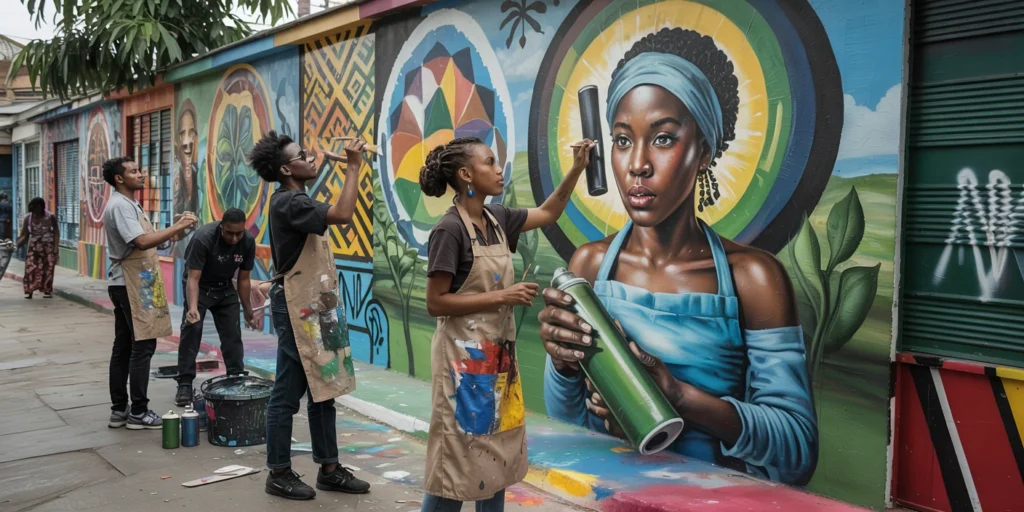
Revival of Cultural Practices
This revival is particularly evident among Kigali’s urban youth, who are actively engaged in integrating traditional elements into contemporary expressions of art and culture. The youth have demonstrated a meticulous attention to detail, incorporating traditional Rwandan clothing, such as Imigongo-patterned attire and Amasunzu hairstyles, into their everyday lives and artistic presentations. This resurgence of cultural pride encourages Rwandans to draw from their own roots, fostering a vibrant generation of artists who are reclaiming their identity and redefining the cultural narrative of the nation.
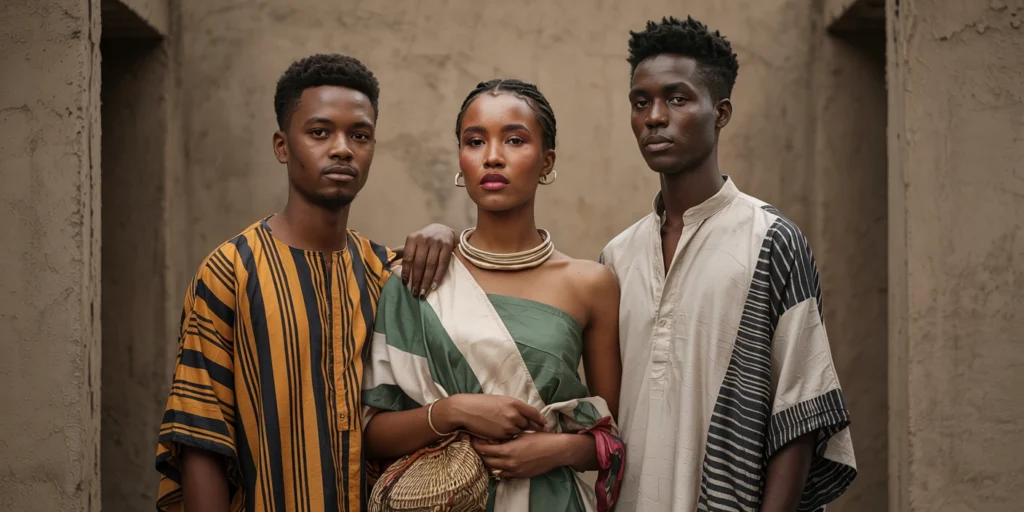
Unity and National Identity
Central to this cultural renewal is the national program Ndi Umunyarwanda, which promotes unity and reconciliation by encouraging open conversations about the genocide’s causes and consequences. This initiative emphasizes the collective identity of Rwandans, transcending ethnic divisions that previously fueled conflict. By focusing on the themes of remembrance, unity, and renewal, the program seeks to heal the wounds of the past and pave the way for a cohesive national identity.
Economic and Cultural Growth
As Rwanda continues to rebuild, the government has set ambitious goals for economic growth, which it sees as essential for improving living conditions across the nation. The Second National Strategy for Transformation outlines plans for significant economic development, targeting sectors such as agriculture, renewable energies, and tourism, while also recognizing the importance of cultural and creative industries in fostering national pride and global recognition. The flourishing arts scene in Kigali, in particular, plays a crucial role in promoting both healing and cultural expression, serving as a testament to Rwanda’s resilience and potential for growth.
Economic Growth in Rwanda
Rwanda’s economy has experienced robust growth over the past decade, characterized by an average annual real GDP growth rate of 6.5% from 2013 to 2023. In 2023, Rwanda’s nominal GDP reached USD 14.1 billion, with a GDP per capita of USD 1,046, significantly lower than the global average of USD 10,589. This growth has been supported by a variety of factors, including public investment, a growing services sector, and regional trade integration.
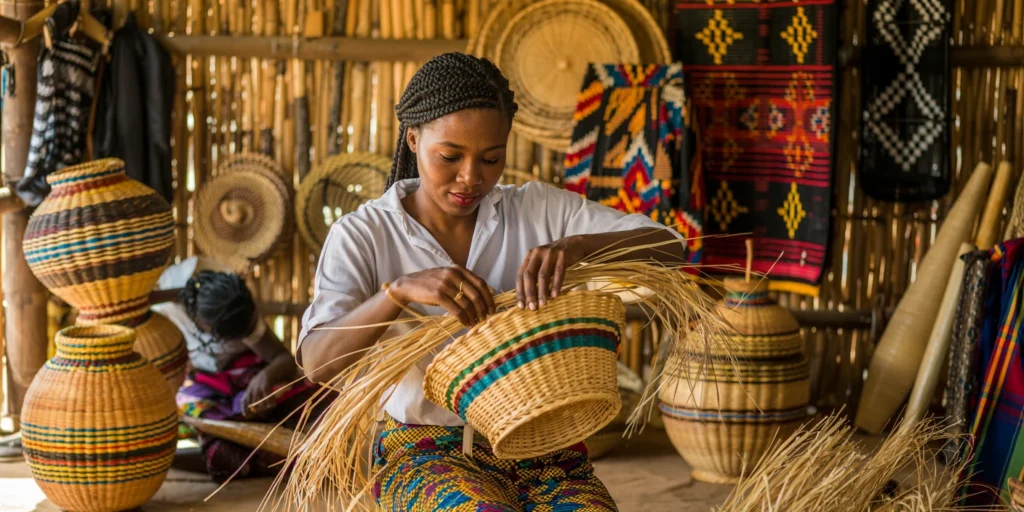
Sector Contributions to GDP
The structure of Rwanda’s economy is diverse, with significant contributions from various sectors. As of 2022, the services sector was the largest, accounting for 44% of the total GDP. This was followed by agriculture at 27%, other industrial activities at 19%, and manufacturing at 10%. Notably, private consumption has played a crucial role in driving economic activity, representing 75% of GDP in 2023, while government consumption and fixed investment contributed 17% and 23%, respectively.
International Trade
Rwanda’s international trade landscape reveals a heavy reliance on imports, with total imports valued at USD 5 billion in 2023 compared to exports worth USD 2 billion. In 2019, Rwanda’s merchandise exports included 10% manufactured products and 27% food, while imports were dominated by manufactured goods, which made up 50% of the total. This trade imbalance underscores the need for Rwanda to expand its industrial base and enhance its export capabilities.
Challenges and Future Outlook
Despite the positive growth trajectory, Rwanda faces challenges that could impact its economic sustainability. The government aims to reduce dependency on external financing and ensure that growth benefits all segments of society. The fiscal deficit averaged 4.3% of GDP over the past decade, and the unemployment rate remained at 12.4%. To maintain its growth momentum, Rwanda will need to foster inclusive growth, expand its industrial sector, and continue to leverage regional trade agreements.
African Creativity and Innovation
Rwanda’s cultural landscape is experiencing a remarkable transformation, characterized by a flourishing contemporary art scene that complements its rich traditional crafts. This resurgence is fueled by a commitment from young creative artists and a robust partnership framework that includes institutions such as the Ministry of Trade and Industry (MINICOM) and other stakeholders.
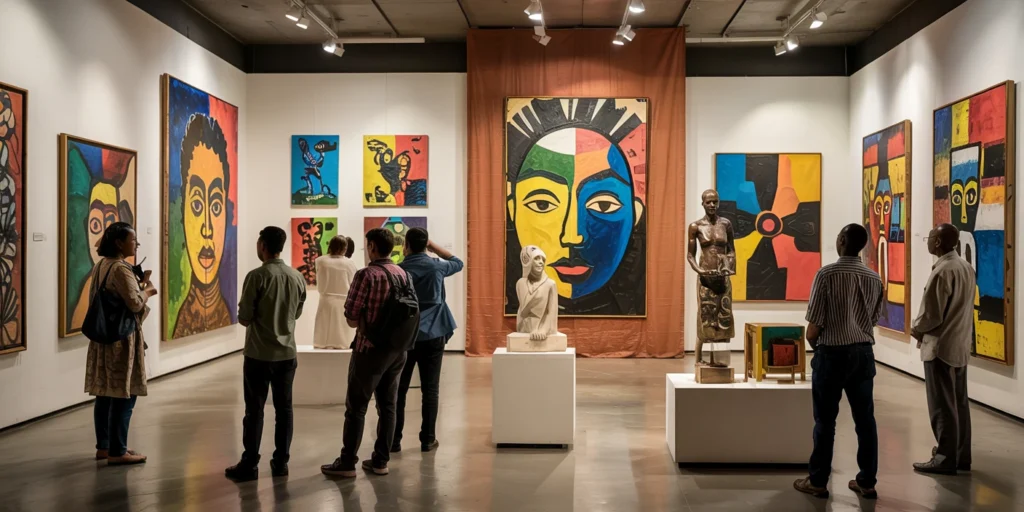
The Rise of Contemporary Art
While traditional crafts maintain a vital role in Rwandan culture, contemporary artists are redefining the artistic expression within the nation. Talented painters, sculptors, and mixed-media artists are exploring innovative ways to address pressing social issues, promote cultural diversity, and inspire change through their work. Artists are producing thought-provoking installations and vibrant street art that not only reflect their individual creativity but also enhance Rwanda’s growing reputation as a hub for artistic innovation.
Key Figures in Rwandan Art
Several Rwandan artists are leading this creative charge and using their platforms to advocate for social change. For instance, Ilibagiza Angela employs paper collage techniques to explore themes surrounding women’s rights and societal expectations placed on women. Her work aims to empower and inspire others, showcasing how art can serve as a vehicle for social commentary and activism. Similarly, Linckah Lydie focuses on themes of family, leadership, and the power dynamics in society, aspiring to use her art as a form of therapy for her audience. Other notable artists include Teta Chel, who addresses taboo subjects such as mental health and women’s sexuality, further illustrating the depth and diversity of contemporary artistic expression in Rwanda.
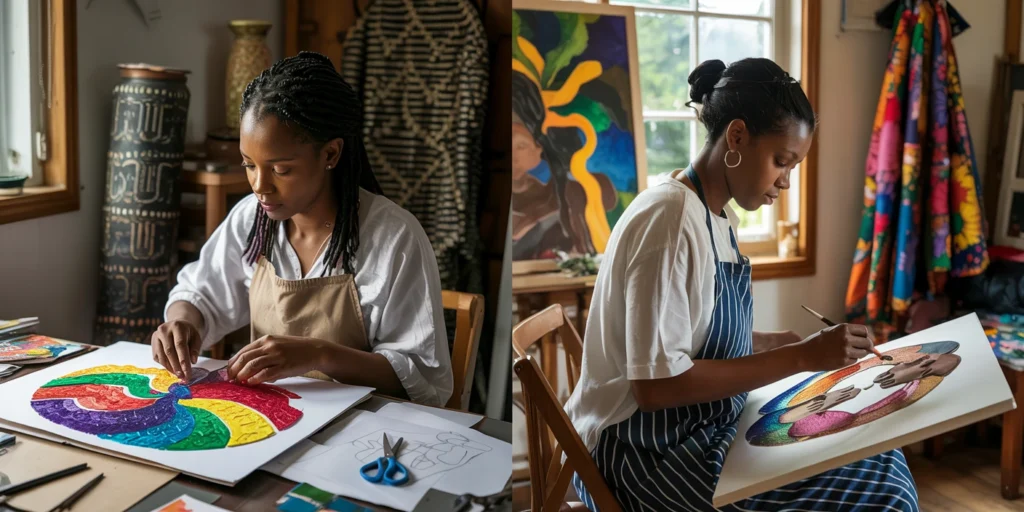
Institutional Support and Community Engagement
Institutions like the Inema Arts Center play a pivotal role in Rwanda’s cultural renaissance by supporting emerging artists and fostering community engagement through art. Initiatives such as the “Made in Rwanda Art Campaign” encourage citizens to appreciate and purchase locally produced art, thus enhancing national pride and recognition of Rwandan creativity. Furthermore, art festivals and collaborative projects promote dialogue around societal issues and cultivate a sense of unity and healing within the community, highlighting the therapeutic potential of artistic endeavors. Through these efforts, Rwanda is not only nurturing its artistic heritage but is also positioning itself on the global stage as a beacon of creativity and innovation in Africa. The commitment to fostering artistic talent and addressing social issues through art reflects a renewed sense of cultural pride that resonates with both local and international audiences.
Cultural Pride in Rwanda
Rwanda’s cultural pride is deeply rooted in its rich heritage and the resilience of its people, which have significantly contributed to a renewed sense of national identity and global recognition. Known as the “Land of a Thousand Hills,” Rwanda’s breathtaking landscapes are complemented by a vibrant tapestry of cultural traditions that span ancient rituals to contemporary expressions of art and community engagement.
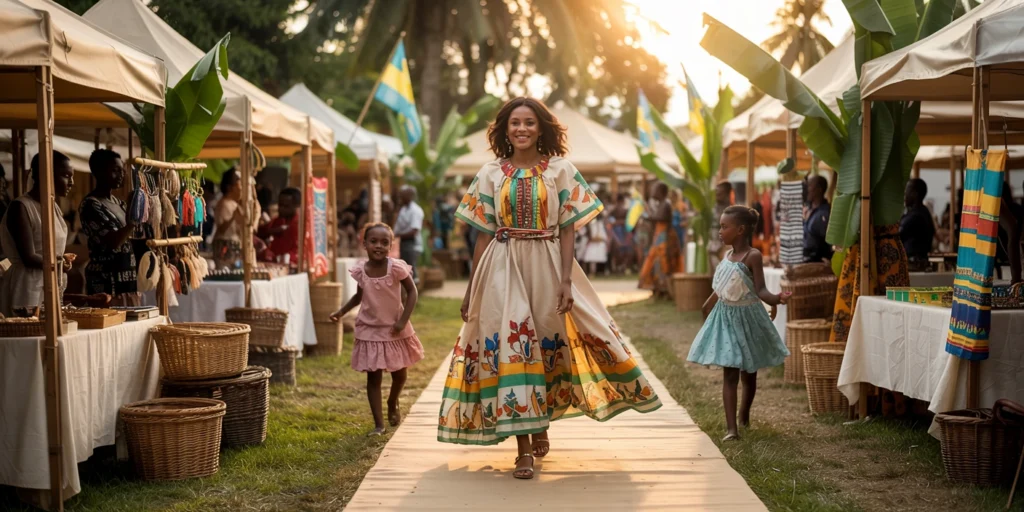
A Mosaic of Ethnic Groups
Rwanda is home to several ethnic groups, primarily the Hutu, Tutsi, and Twa. While these ethnic distinctions have historically been significant, the country’s post-genocide reconciliation efforts have shifted the focus toward a unified Rwandan identity that transcends ethnic boundaries. The rejection of ethnic markers in favor of a collective national identity has been a cornerstone of peacebuilding strategies, fostering a sense of unity among the diverse population.
Community and Cultural Initiatives
Rwanda’s commitment to cultural pride is evident through various community-led initiatives and events that celebrate the nation’s heritage. Festivals like the Rwanda Cultural Fashion Show and the Rwanda Art and Craft Exhibition showcase the fusion of traditional craftsmanship with contemporary design, providing platforms for local artisans to display their talents. These events not only enhance cultural appreciation but also stimulate local economies by promoting micro-enterprise development and job creation within communities.
Emphasizing Heritage and Identity
The emphasis on heritage in shaping personal and collective identity plays a crucial role in fostering pride among Rwandans. As part of President Kagame’s post-genocide reconciliation efforts, initiatives like Umuganda encourage collective participation in community projects, reinforcing the idea of a single, united Rwandan identity while bridging historical divides. This holistic approach underscores the importance of culture in national development and social cohesion, enabling Rwandans to reclaim their narrative and promote a positive image globally.
Global Recognition
Rwanda has increasingly gained global recognition for its vibrant cultural scene and creative initiatives that reflect a deep connection to its heritage. This revival of traditional customs, particularly among Kigali’s urban youth, emphasizes a meticulous incorporation of Rwandan elements such as Imigongo-patterned clothing and Amasunzu hairstyles. As this youthful generation of artists emerges, there is a growing emphasis on drawing inspiration from local roots rather than imitating external influences. The integration of traditional arts into contemporary practices not only reinforces cultural identity but also promotes sustainable tourism and community development.

Organizations Initiative for Sustainable Development have fostered partnerships with international entities to elevate these cultural expressions and enhance the livelihoods of local artists. By facilitating the practice, exhibition, and sale of both traditional and contemporary artworks, these initiatives contribute to a culture of nature awareness and conservation while generating economic opportunities for the communities involved.
Moreover, community tourism initiatives in Rwanda frequently collaborate with tour operators, lodges, and government agencies to ensure responsible tourism practices that equitably distribute benefits among the local population. Such partnerships provide crucial training, marketing support, and infrastructure development, further solidifying Rwanda’s position on the global stage as a hub for cultural exchange and creativity. In this context, events supported by the Rwandan government and local partners aim to promote artistic expression and creativity, enhancing the country’s reputation as a cultural beacon in East Africa. The ongoing recognition of Rwandan culture and its innovative expressions not only enriches the local communities but also enhances Rwanda’s standing in international cultural dialogues.
👉 Explore more stories celebrating African excellence in our journal
Sources
1. [PDF] An Assessment of Artistic Freedom: Rwanda
2. [PDF] The Rwanda Art Museum, Haunted By Its Past – eScholarship.org
3. Heritage decolonization and community engagement in Nyanza
4. “Heritage Hub” in Rwanda to use culture for youth economic empowerment
5. Enhancing Artistic Freedom in Rwanda’s Cultural Landscape
6. Rwanda’s Tourism, Culture and Governance and More: Why you should visit more than once
7. Women’s and youth empowerment in one of the world’s ‘best tourism’
8. Beyond Conflict and Spoilt Identities: How Rwandan Leaders Justify
9. Rwanda: LGBT rights are protected on paper, but discrimination and homophobia persist
10. [PDF] Practical approaches to localisation in peacebuilding: Rwanda
11. In Rwanda, Looking to Art to Soothe – The New York Times
12. Rwanda Overview: Development news, research, data | World Bank
13. Rwanda – Market Overview – International Trade Administration
14. Economy and Business – Rwanda
15. Rwanda, 20 years on: how a country is rebuilding itself – The Guardian
16. Rwanda Economy: GDP, Inflation, CPI & Interest Rates
17. Research commends Rwanda’s remarkable strides in decentralisation – Minaloc
18. [PDF] Five year Strategic Plan for the development of Creative Arts
19. Why artists shouldn’t miss out Digital Training Opportunity – Rwanda
20. Rwand-art to help external relations – Bailiwick Express News Jersey


[…] How Rwanda growth and African creativity inspire a renewed sense of cultural pride and global recogn… […]